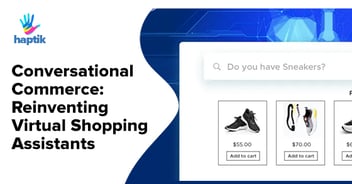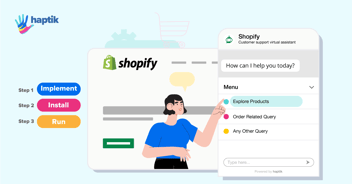The eCommerce revolution paved the way for online shopping from the comfort of the customer’s home. And the next big development in the Retail space has been Conversational Commerce. It combines the speed and convenience of eCommerce with the interactivity and personalized assistance of an in-store retail experience.
From messaging apps to AI-powered chatbots, there are a number of mediums and platforms that can facilitate conversational commerce. But one platform in particular has emerged in recent years as a favorite among consumers and brands alike - voice assistants.
Voice-based platforms offer the added advantage of getting things done completely hands-free through simple vocal commands. And one of the things people most like getting done through voice assistants is online shopping!
Let us examine a few of the key factors that are driving this growth in voice commerce.
#1 The Boom in Smart Speaker Adoption

One of the major reasons for the growth in voice commerce is simply the availability of smart speakers. Alexa, Siri, Google Assistant and other similar smart speakers have become almost as ubiquitous in households as television sets. Juniper predicts that by 2022, 55% of American households will own a smart speaker, and that by 2023, there will be 8 billion voice assistants in use. Statista expects global smart speaker revenue to exceed $35.5 billion by 2025.
Needless to say, over the next few years, a lot of people will be buying smart speakers. And a large chunk of these people will be using their speakers to make retail purchases - 62% of smart speaker owners have used their speakers for voice commerce. So the projected increases in smart speaker ownership are only likely to grow the size of the voice commerce pie over the next several years.
#2 Advances in Voice-Based AI Technology

Another factor driving the growth in voice assistants are the significant advancements in AI that have been made over the past decade.
Since 2012, voice assistants have been leveraging deep neural networks to enhance their ability to understand users. A significant breakthrough came in 2019, with Google’s introduction of its BERT model into its search algorithm RankBrain. The BERT model analyzes each word in a search query in relation to the other words in the query - which helps the algorithm better comprehend the user’s intent. This has led to Google’s speech recognition technology having a 95% accuracy rate when it comes to understanding queries spoken in English.
Machine Learning is a key AI technology for voice assistants. It is what enables AI to learn on its own and get ‘smarter’ as it is fed more data. The massive growth in the use of smart speakers and other voice-enabled devices in recent years means that the algorithms behind voice technologies are exposed to increasingly larger amounts of data, thus becoming more intelligent at an exponential rate.
Google and Alexa are both in the process of developing technologies that would enable their voice assistants to detect the emotions of customers from their voice commands. If widely implemented, this would be a boon for brands - enabling them to target customers with relevant offerings based on their mood. And no less than Danny Hostantinovic, the creator of Apple’s Siri, predicted a scenario wherein voice assistants would be able to access multiple eCommerce platforms at the same time and help the customer compare products and prices!
These, and many more developments across the entire spectrum of the voice technology ecosystem, will significantly enhance the user experience and functionality of voice assistance, further driving its adoption by brands and consumers.
READ MORE: 8 Proven Ways to Implement Conversational Commerce for Your eCommerce brand
#3 A Frictionless Customer Experience
A key appeal of conversational commerce is its ability to virtually replicate the experience of visiting a store and being guided by a helpful and knowledgeable sales assistant. From the comfort of their homes, customers can explain what they’re looking for in simple terms, enquire about prices and product features, ask follow-up questions, and even get personalized recommendations based on their shopping history and past behavior!
Voice assistants make this experience even more frictionless and interactive. At a time when consumers spend a large chunk of their lives typing or sweeping their thumb across mobile screens, voice-based platforms reduce screen interaction and offer a more convenient hands-free experience.
Unlike interacting with purely textual chatbots, which can feel like talking to a machine, interacting with a voice assistant can feel like having a conversation with a friend, making the experience feel even more personalized and engaging. Voice assistants also provide speedy responses and significantly reduce the time taken for checkout.
The ease and convenience of searching, selecting and transacting of voice has been a major driver of its adoption by customers. According to PwC, 71% of consumers would prefer to use voice assistants to search for something, while Capgemini has found that 41% of consumers would prefer a voice assistant over a website or app while shopping online.
ON-DEMAND WEBINAR: The Big Retail Reset - The New Way of Buying in 2021
#4 The Increased Demand for Contactless Shopping

COVID-19 has had a significant impact on every sector, and retail is no exception. According to Adobe, 58% APAC consumers increased their online shopping during the pandemic; while a Deloitte report revealed that only 12% of consumers expected to shop in an enclosed mall after the pandemic, as compared to 24% before. The reluctance of consumers to risk a trip to a brick-and-mortar store has led to a surge in demand for contactless shopping options,
According to a consumer expenditure survey by the US Bureau of Labor Statistics, eCommerce saw growth comparable to 10 years over 10 weeks during the early months of the pandemic. If this trend holds, it is estimated that online shopping would account for $158 billion in sales that would otherwise have taken place in physical retail outlets.
At the same time, voice assistants have become a greater part of people’s lives - according to NPR, 24% of Americans own smart speakers in 2020 (up from 21% the previous year), with 29% of smart speaker owners possessing three or more devices! 52% of voice assistant users claim that they use their devices several times every day since the pandemic hit.
Thus, the demand for contactless shopping, coupled with the accelerated adoption and usage of voice assistants, will serve as a powerful driver for voice commerce over the next few years. Voice shopping, once it becomes ingrained in consumer behavior, is likely to thrive long after the pandemic is over.
To sum up
Voice commerce is on its way to becoming a key retail channel, owing to a large extent due to these factors:
- Large-scale adoption of smart speakers over the next few years, with a significant number of smart speaker owners using them for commerce.
- Advances in AI technology that improve the voice commerce experience, including speech recognition, mood detection, and more.
- A hands-free, interactive, and frictionless customer experience that replicates the feeling of interacting with a friendly and helpful sales clerk.
- COVID-19 fuelling increased demand for contactless shopping options among customers, coupled with greater use of voice assistants during the pandemic.
As we move towards a voice-first world, with a smart speaker (or three!) in every home and people coming to rely even more on their smart phone’s voice assistants, it is incumbent upon brands to embrace this paradigm shift, or risk being left behind!



.png?quality=low&width=352&name=main-ecommerce-blog%20(1).png)







.webp?width=352&name=new-whatsapp-ecom%20(1).webp)




